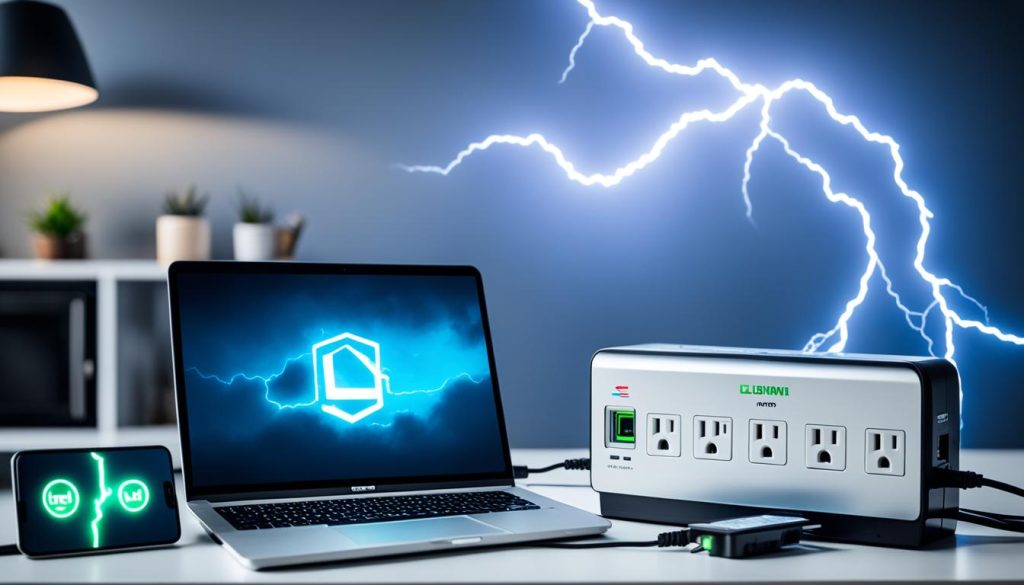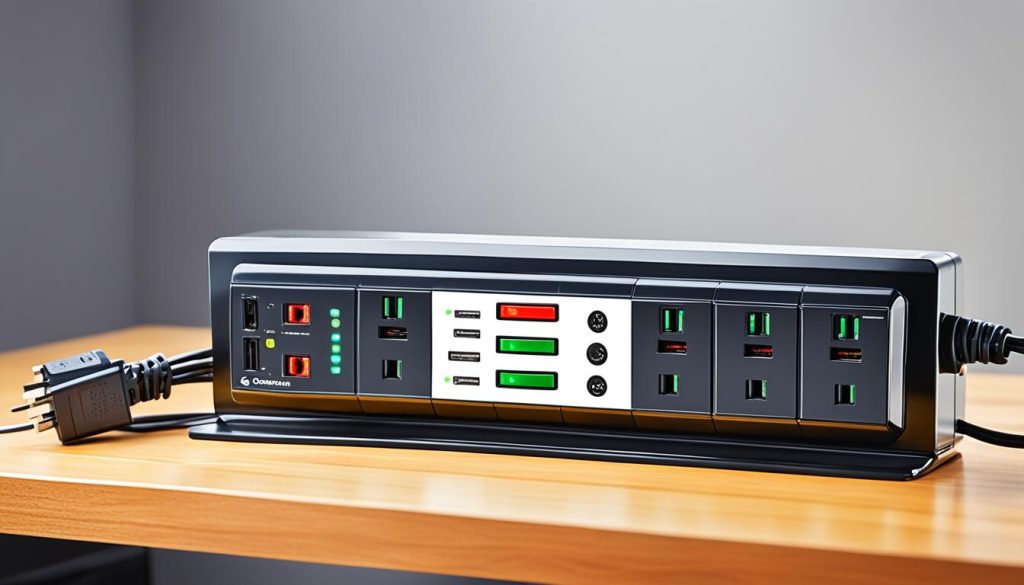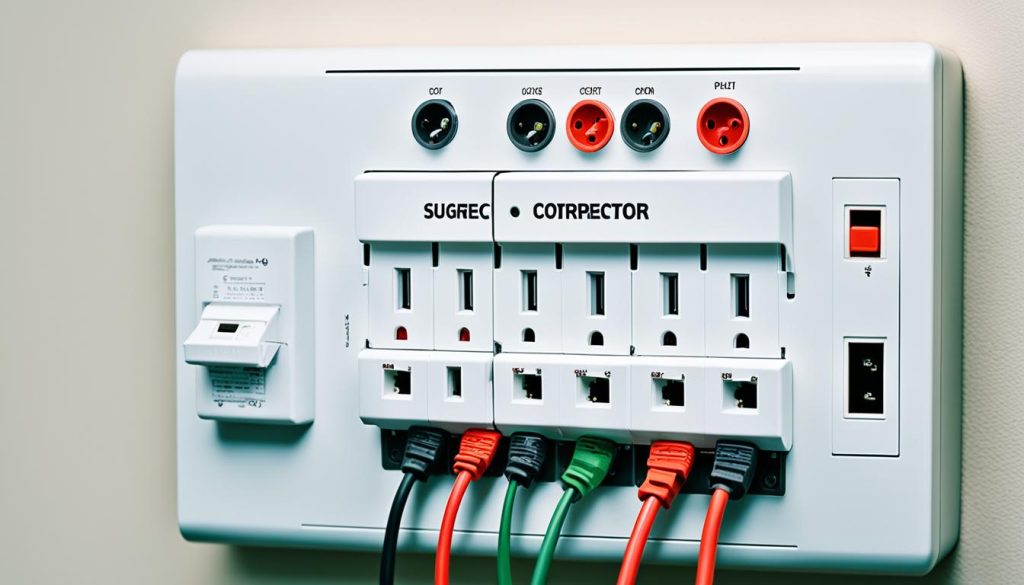A surge protector is an essential component for protecting your electronic devices from power surges, faulty wiring, and voltage fluctuations. It acts as a barrier, absorbing excess voltage and diverting it to a ground wire, preventing damage to your connected devices.
When it comes to choosing a surge protector, there are a few important factors to consider. From power rating to joules of protection, understanding your needs and the specifications of surge protectors can ensure optimal performance and protection for your devices.
Surge protectors come in various types to cater to different needs. Whether you’re looking for a power strip surge protector for personal use or a rack mount surge protector for data centers, there’s a surge protector available to suit your requirements.
This surge protector buying guide will provide you with valuable information on how to choose the right surge protector and safeguard your devices effectively.
Key Takeaways:
- Surge protectors are crucial for protecting electronic devices from power surges and voltage fluctuations.
- Factors to consider when choosing a surge protector include power rating, joules of protection, and the type of outlets and ports you need.
- Surge protectors come in different types, such as power strip surge protectors and rack mount surge protectors.
- Important features to look for in a surge protector include indicator lights, UL listing, and warranty information.
- Devices such as computers, home theater systems, and gaming consoles benefit from surge protection.
How Surge Protectors Work
Surge protectors play a vital role in safeguarding your electronic devices from power surges and voltage fluctuations. But have you ever wondered how surge protectors actually work? Let’s dive into the details to understand the inner workings of these essential devices.
At the heart of a surge protector are Metal Oxide Varistors (MOVs), which are the key components responsible for suppressing voltage spikes. When a power surge occurs, the MOVs divert the excess voltage to the ground wire, protecting your devices from potential damage.
The absorbing capacity of a surge protector is measured in joules of protection. Higher joule ratings indicate a greater capacity to absorb power surges. It’s imperative to choose a surge protector with sufficient joules of protection to ensure optimal safeguarding.
One crucial feature to look for in a surge protector is the indicator light. This light serves as an indication that the surge protector is functioning correctly and actively protecting your devices. It provides peace of mind and reassurance that your valuable electronics are shielded from potential power surges.
It’s important to note that surge protectors are not infallible and may degrade over time, especially after major power events or extended usage. Regular monitoring and maintenance are essential to ensure ongoing protection for your devices. It’s recommended to replace surge protectors every few years to maintain their effectiveness.
Understanding how surge protectors work empowers you to make informed decisions when it comes to protecting your valuable electronic devices. Remember to choose a surge protector with sufficient joules of protection and keep an eye on the indicator light to ensure your devices receive the utmost protection against power surges.
What Devices Need a Surge Protector
When it comes to protecting your valuable electronics, surge protectors are a must-have. By safeguarding your devices from power surges, you can avoid potential damage, data loss, and expensive repairs. To ensure the longevity and reliability of your electronic equipment, it’s important to know which devices should be plugged into surge protectors.
Electronics that Need Surge Protectors
- Computers: Your computer is the hub of your digital life, storing important files, documents, and memories. Plugging your computer into a surge protector can shield it from power surges and prevent data corruption.
- Home Theater Systems: Whether you enjoy movie nights or gaming marathons, a home theater system is a significant investment. Surge protection for home theater systems ensures that your expensive equipment, including televisions, speakers, and gaming consoles, remains safe from electrical fluctuations.
- Smartphones and Tablets: As our constant companions, smartphones and tablets are susceptible to power surges. By connecting them to surge protectors, you can prevent potential damage to their delicate circuitry and extend their lifespan.
Surge Protection for Computers
Computers are especially vulnerable to power surges due to their sophisticated and interconnected components. A sudden surge of voltage can cause irreversible damage to the motherboard, hard drives, and other integral parts. By using surge protection for computers, you can effectively shield them from these electrical fluctuations and ensure their smooth operation.
Surge Protection for Home Theater Systems
A home theater system typically consists of multiple components, including a television, speakers, gaming consoles, and streaming devices. All of these devices are interconnected, making them highly susceptible to power surges. By employing surge protection for home theater systems, you can safeguard these valuable investments and enjoy uninterrupted entertainment.
Surge Protection for Critical Data Center Infrastructure and Servers
In addition to personal electronics, it’s crucial to consider surge protection for critical data center infrastructure and servers in professional settings. These components store and process large amounts of data, making them highly vulnerable to power surges. By integrating surge protectors into your data center, you can prevent potential damage and ensure uninterrupted data processing.

Picking the Right Type of Surge Protector for Your Needs
When it comes to choosing a surge protector, it’s important to consider your specific needs and requirements. There are different types of surge protectors available in the market, each designed for distinct purposes. Two popular options are power strip surge protectors and rack mount surge protectors.
Power strip surge protectors:
Power strip surge protectors are versatile and commonly used for home and personal usage. They offer multiple outlets, allowing you to connect multiple devices simultaneously. Power strip surge protectors come with various cord lengths, catering to your specific distance from the power source. Whether you need to protect your computer, TV, gaming console, or other electronic devices, a power strip surge protector provides a convenient and practical solution.
Rack mount surge protectors:
Rack mount surge protectors are specifically designed for data centers and network components. They are typically installed in server racks and provide protection against surges that may damage critical equipment, such as servers, switches, and routers. These surge protectors feature multiple outlets, allowing efficient power distribution to multiple devices while safeguarding them from voltage fluctuations and power surges.
When selecting a surge protector, it’s crucial to consider important specifications that ensure compatibility and optimal protection. Some key specifications to look for include:
- Indicator lights: These lights provide visual feedback on the surge protector’s status, indicating whether it is functioning correctly or needs attention.
- UL listing: Choose surge protectors that have undergone rigorous testing and meet safety standards set by Underwriters Laboratories (UL).
- Power ratings: Consider the power rating of the surge protector to ensure it can handle the electrical demands of your devices. Exceeding the power rating may lead to inefficient performance or even damage to the surge protector itself.
By carefully considering the type of surge protector and its specifications, you can ensure that your devices are adequately protected from power surges and voltage fluctuations, extending their lifespan and providing you with peace of mind.

| Type | Key Features |
|---|---|
| Power Strip Surge Protectors |
|
| Rack Mount Surge Protectors |
|
What to Consider When Choosing a Surge Protector
When it comes to protecting your valuable devices from power surges, selecting the right surge protector is essential. Consider the following factors to ensure you make the best choice:
- Safety Features: Look for surge protectors with safety features, such as UL listing. This certification guarantees that the device meets rigorous safety standards and provides reliable protection for your devices.
- Indicator Lights and Power Shutdown: Opt for surge protectors equipped with indicator lights that alert you to the device’s functionality. Some surge protectors also have power shutdown features, automatically cutting off the power in the event of a surge to prevent overload and potential damage to your electronics.
- Power Rating: Carefully check the surge protector’s power rating to ensure it can handle the amperage requirements of your devices. Choosing a surge protector with an insufficient power rating may lead to inadequate protection and increased risk of damage.
- Warranty and Connected Equipment Guarantee: Protect your investment by selecting surge protectors with comprehensive warranties. A reliable warranty provides peace of mind and financial protection in case of any unforeseen issues. Additionally, consider surge protectors that offer connected equipment guarantees, which cover the repair or replacement of your devices in the event of a surge-related failure.
By considering these factors, you can confidently choose a surge protector that offers optimal protection and peace of mind for your valuable devices.

Comparison of Surge Protector Safety Features
| Safety Feature | Description | Brand A | Brand B | Brand C |
|---|---|---|---|---|
| UL Listing | Ensures compliance with safety standards | ✓ | ✓ | ✓ |
| Indicator Lights | Provides visual confirmation of functionality | ✓ | ✓ | |
| Power Shutdown | Automatically cuts off power during a surge | ✓ | ✓ | |
| Connected Equipment Guarantee | Covers repair or replacement of devices | ✓ | ✓ |
Additional Features to Consider in a Surge Protector
When selecting a surge protector, it’s important to look beyond the basic protection it offers. Many surge protectors come with additional features that can enhance convenience, safety, and energy efficiency in your daily life.
One such feature is energy-saving functionality. Some surge protectors are equipped with energy-saving modes that automatically turn off power to attached devices when they are not in use. This not only helps reduce your energy consumption but also extends the lifespan of your devices.
LED lights are another useful feature to consider. Surge protectors with built-in LED lights provide easy visibility in low-light conditions, allowing you to quickly locate and connect your devices, even in the dark.
Mounting options are also worth considering. Surge protectors that offer wall or furniture mounting options provide a neat and organized solution for managing your cables and devices. This can be particularly helpful in home offices, entertainment centers, or areas with limited space.
Additionally, for the safety of your family, look for surge protectors with tamper-resistant outlets. These outlets are designed to prevent accidental insertion of foreign objects, reducing the risk of electrical shocks and potential damage to the surge protector.
For added peace of mind, consider surge protectors with fireproof technology. These surge protectors are built to withstand and contain any incidents of fire caused by electrical surges, providing an extra layer of protection for your devices.
Lastly, don’t forget to check the warranty options. A surge protector with a warranty not only ensures that you are covered in case of any product defects or malfunctions, but it also reflects the manufacturer’s confidence in the product’s quality and durability.
Remember, when choosing a surge protector, consider your specific needs and preferences. Look for the features that align with your lifestyle and provide the necessary protection for your devices. By selecting a surge protector that offers energy-saving functionality, LED lights, mounting options, tamper-resistant outlets, fireproof technology, and warranty coverage, you can safeguard your devices and enjoy greater convenience and peace of mind.
FAQ
How do surge protectors work?
Surge protectors work by using Metal Oxide Varistors (MOVs) to suppress voltage spikes and divert excess voltage to the ground wire. They absorb and redirect the excess voltage away from your connected devices, protecting them from potential damage.
What devices need a surge protector?
Devices that have sensitive components and are expensive should be plugged into surge protectors. This includes computers, home theater systems, gaming consoles, smartphones, and tablets. Surge protectors provide an extra layer of protection and help prevent data loss or costly repairs.
What are the different types of surge protectors?
There are two main types of surge protectors. Power strip surge protectors are versatile and commonly used for home and personal use. Rack mount surge protectors are designed for data centers and offer protection for network components. Consider your specific needs and choose accordingly.
What should I consider when choosing a surge protector?
When choosing a surge protector, it’s important to consider factors such as safety features, power rating, and warranty. Look for surge protectors with UL listing, indicator lights, and power shut down protection for added safety. Check the power rating to ensure it can handle the amperage requirements of your devices. Warranty options provide long-term peace of mind.
Are there any additional features to consider in a surge protector?
Yes, surge protectors may offer additional features such as energy-saving functionality, LED lights for visibility in the dark, and mounting options for easy installation. Consider surge protectors with tamper-resistant outlets for child safety, fireproof technology for added protection, and warranty options for extended coverage.


